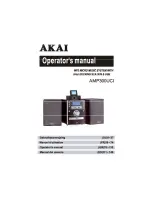
Playback
••••
71
Note that the percent value relates to the length of the fade. So increasing the percent
value increases the length of the fade and vice-a-versa.
Master Precedence
Because the console can simultaneously run sixteen (or eight) separate cuelists on faders and more on
virtual masters, there is possible conflict over which master actually has control of a parameter. In order to
decide which master has control, the console applies the following rules:
For focus, colour and beam parameters:
•
The console uses Latest Takes Precedence (LTP). This means the most recently activated masters will
override earlier masters (Note: Only the specific conflicting parameters are over-ridden; non-
conflicting parameters on the earlier masters will be left untouched).
•
Releasing overriding masters will return the overridden parameters back to the control of the old
masters.
•
Masters which are fully over-ridden (ie. all programmed parameters have been over-ridden by other
masters) are released automatically as soon as all parameters are over-ridden. This is called stomping.
•
The Programmer always has priority over the Playback Masters (remember, you can press
Blind
to
suspend Programmer output).
For intensity parameters:
•
By default these are also controlled by LTP, but you can set cuelist options to make a master work in a
Highest Takes Precedence (HTP) fashion. In this case the console will output, for a particular intensity
channel, the highest programmed value of all the HTP masters and the highest priority LTP master.
Cuelist options exist for fully customising the priority scheme for a cuelist. See the Cuelist Options section
of this chapter for more information.
What is an Active Master?
An active Master is a master that has had
Go
pushed, has been manually faded up, or has been activated
using
Choose
+
Flash
.
Masters, once activated, remain active until they are either fully over-ridden and thus stomped
(automatically released), or they are manually released. Partially over-ridden masters are still active, and
thus still control the remaining, non-over-ridden parameters. Cuelist options exists for customising this.
Playback Master LEDs
The Masters’ LEDs give feedback as to the active and over-ride status of a master.
LED
Solid
Flashing
Go
Executing Crossfade
Crossfading, but fully over-ridden
Halt
Controlling Colour, Beam
All CBF over-ridden, or no CBF
or Focus Parameters
Flash
Controlling Intensity
All I over-ridden, or no I
Default Values
When no playback masters are active, and nothing is selected in the Programmer, the console will output
the default values for each parameter of every fixture. These values may be modified in the fixture library
of each individual fixture.
Customising Playback with Cuelist Options
Hold
Pig
and press a
Choose
button to open the cuelist window for that master. Press
Options
on the
cuelist toolbar to customise the response of a Playback Master. Chase options are covered separately in the
chase section.
Summary of Contents for HOG 1000
Page 1: ...Software Version 3 20...
Page 12: ...6 HOG Version 3 20 This Page intentionally Left Blank...
Page 22: ...16 HOG Version 3 20 This Page intentionally Left Blank...
Page 50: ...44 HOG Version 3 20 This Page intentionally Left Blank...
Page 62: ...56 HOG Version 3 20 This Page intentionally Left Blank...
Page 74: ...68 HOG Version 3 20 This Page intentionally Left Blank...
Page 90: ...84 HOG Version 3 20 This Page intentionally Left Blank...
Page 94: ...88 HOG Version 3 20 This Page intentionally Left Blank...
Page 119: ...Fixture Library 113...
Page 123: ...Hardware Notes 117 This Page intentionally Left Blank...
















































